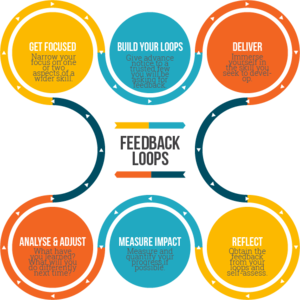Fred is an ambitious, extremely conscientious middle manager at a financial services firm. He has been a people manager for a couple of years, and struggles with all of the things middle managers struggle with.
His organisation – XYZ Corp – are trying to support his development and performance, to send Fred on a leadership development program. Fred arrives back in the office after the program highly motivated, energised to make the changes he needs to be a more effective leader, drive business results, develop his team and himself, and get control of his life and career.
At the end of the program, Fred had publicly committed to three major changes, all to be delivered within six months of the program ending.
Six months on, Fred reviews his “new leadership commitments.” He realises that he hasn’t achieved any of the changes; in fact, he hasn’t even thought about them for months. Fred experiences a mixture of emotions: disappointment in his failure to make changes, fear that things will never get better, worry that he has let his team down.
Talking to our clients – and many business people who have attended numerous leadership programs during their careers – we all understand that far from being a poor performer, Fred’s predicament is typical.
Most programs – regardless of brilliant design and facilitation, and a huge commitment by motivated participants to “make the change” – fail to land key new leadership behaviours that lead to elevated business results. What gets in the way?
What are the barriers, and how do they manifest?
HFL undertook a research project to examine what makes the difference between participants successful implementing the behaviour changes they have nominated – what helps “land” leadership programs – and what gets in the way. We have worked extensively with several clients to understand the dynamics of what we call “landedness”.
Our progressive research among participants reveals five consistent barriers to landedness:
- Time
No surprises here. Returning from a workshop, participants are sucked into the vortex of work – often having to immediately play catch up from the time they have been away.
Few executives we work with have any spare time – so commitments to do “more” with their people get loaded onto already full schedules.
The inability to prioritise, inability to delegate, inability to escape reactive-mode (the default setting for many middle managers in particular), and inability to decide what to stop doing and act on that decision are typical traits that lead to time being the #1 barrier to new leadership behaviours landing.
- Lack of support
Once the learning group is split up and return to work, participants feel isolated. Lack of support can manifest in many ways.
Participants revel in peer discussions about common challenges at the program, but this support is no longer available back at work.
Participants’ managers are commonly not as supportive as they could be. This is particularly true when the managers have not been exposed to the same programs or content.
Thirdly, the participants’ team are often initially cautious or push back on proposed changes. This often surprises and de-motivates the returning leaders.
- Staying the course
Respondents report that the third most common barrier to landedness is staying the course.
Many factors contribute to this inhibitor – participants getting too ambitious with commitments and then quickly fall behind, small failures erode confidence, and follow-up systems and Accountability Loops are not robust enough.
The transition from managing to leading is hard, and in our experience even the most determined participant requires regular support, encouragement, and external confirmation that the course of action they are taking is the right one.
- External factors
External factors that impact the ability of participants to land new leadership behaviours provide great excuses for inaction or retraction of commitments.
These might include systems not being applied consistently across teams (particularly by senior leaders), misaligned incentive schemes, the magnetic call of clients demanding time, and systems not keeping up with new people processes.
- Change fatigue
Nearly all clients we work with these days are undergoing significant change programs of one form or another. And if a change program isn’t current, then usually the organisation is recovering from a recent major change.
Participants returning from a leadership workshop with yet another raft of changes that need to be implemented are met with a team that is already exhibiting change fatigue, and all of the resistant behaviours that go with this condition.
Participants often struggle to create a positive atmosphere in an overall negative or uncertain environment.
What else?
This list is by no means comprehensive, but these five barriers constitute the most commonly stated barriers to progress reported by participants.
Create solutions to overcome these five, and most other barriers are generally not material. The barriers we have described above would not be news to most leadership development professionals.
We might add that our research shows that these barriers exist even when some of these challenges – such as time management and change fatigue – are covered in detail in the program
Breaking through the barriers: forming robust Accountability Loops
The creation of a clear – and mandated – Accountability Loop is essential if these barriers are to be overcome. These loops, however, demand resources and discipline, and these are often in very short supply.
The Accountability Loop needs to involve multiple stakeholders, and support mechanisms. There need to be consequences for non-delivery.
Delivery must involve SMART goals, material deliverables that can be measured and assessed for impact. The group must be kept together, with check-ins and recalls evenly spaced to assist support, advice, and accountability.
Time frames need to be sensible – HFL prefers six month plans for example, rather than twelve month ones.
Reporting mechanisms need to be religiously executed, ensuring the feedback goes to the participants as well as the organisation and sponsors.
The effectiveness of these loops is evident from participant feedback, if designed and executed well. As we have refined what the HFL Accountability Loops look like, we have achieved demonstrably better landedness (factors of two or three times effectiveness are common).
While initially seen as further imposts on their limited time, participants we have worked with come to really value and engage with the activities and disciplines.
Indeed, the entire concept of an Accountability Loop has very broad and effective applications across their teams.
Most important of all, the Loops allow participants to really make those changes, support each other through the tough times, and see clearly how a little change executed well can have significant impact on team engagement and performance.
It’s not easy
But these loops aren’t easy to build, or maintain.
The reality is that a well designed Accountability Loop has many moving parts, is a significant investment in time and effort, requires disciplined project management, and those responsible for its execution need to be as accountable for execution of the loop.
In our experience over the past two years, they are best co-designed (by the program designers and HR Business Partner team that support participants), and then co-executed – but with some clear (and paid for) accountability from the designers.
If you are working with a group of program designers that are constantly looking to improve landedness, then they will be highly motivated to support the activity.
Another key lesson has been that the way in which loops are promoted (key messages), and communication channels are maintained, are both critical success factors.
HFL has now developed a robust Accountability Loop process. An Accountability Loop is now an essential element of every program we newly design (or incorporated in our annual review and re-designs of existing programs).
For more information, or to see a copy of our research into the barriers that get in the way of leadership programs being a success, please contact us (or fill in the form below!)




